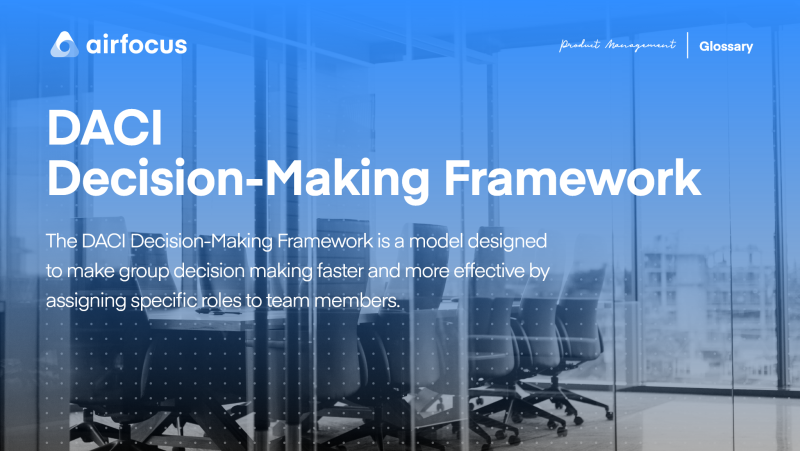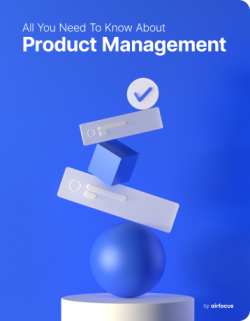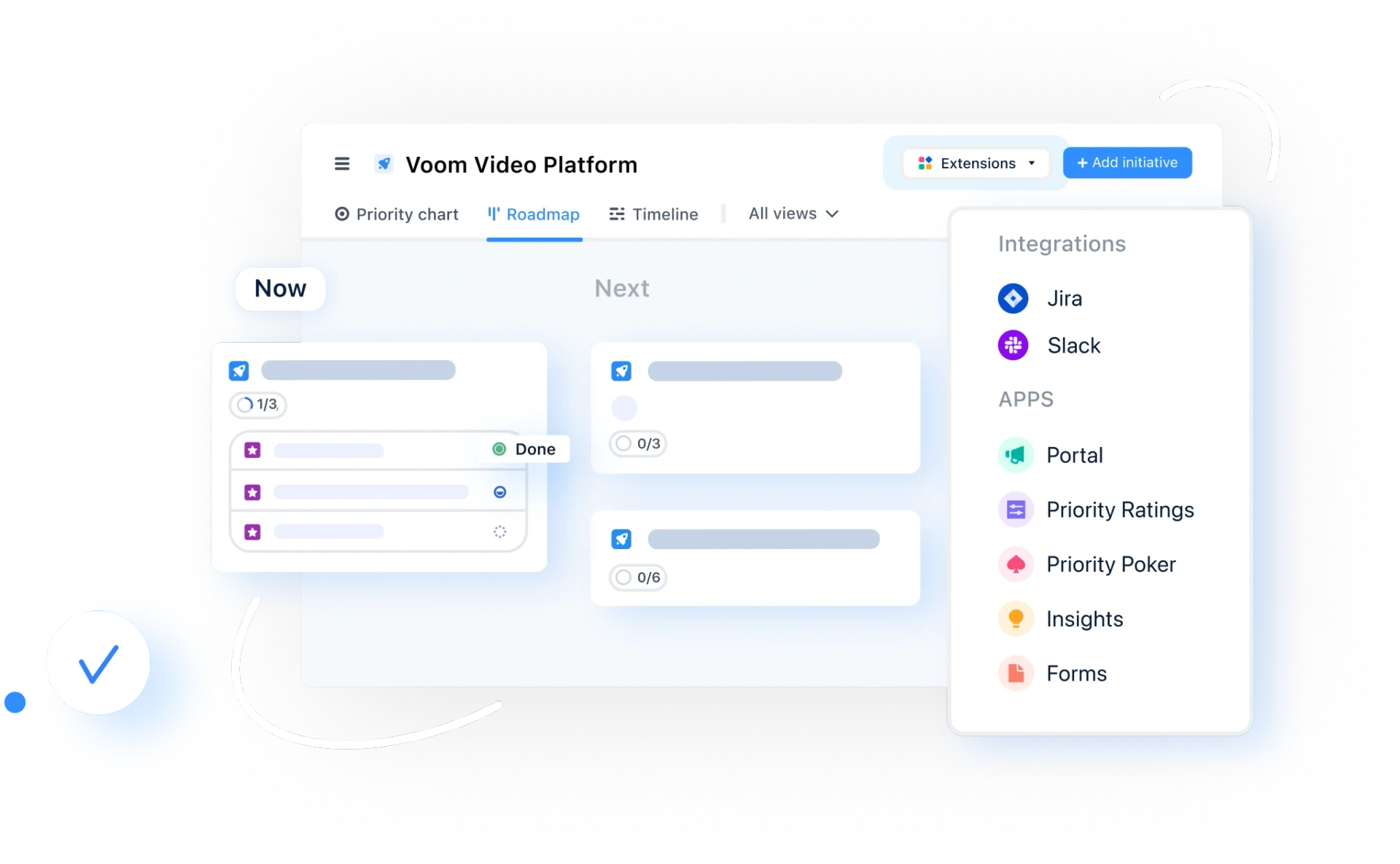DACI Decision-Making Framework
What is the DACI decision-making framework?
Definition of the DACI decision-making framework
The DACI decision-making framework is a model designed to make group decision making faster and more effective by assigning specific roles to team members.
Working on projects as a group is often the best way to get things done, but when it comes to making decisions? That’s when things can get difficult. With so many competing opinions and ideas at the table, coming to a consensus as a group can seem like an impossible task.
The DACI decision-making framework aims to resolve this issue.
The model is based around the idea that decisions will be made faster and more efficiently if certain people are assigned roles within the group. This establishes clear lines of responsibility, lending authority to certain members of the group, reducing friction and the possibility of arguments occurring.
What are each of the roles in the DACI Decision-Making Framework?
Before work begins on any project — in this case, product development — the DACI model requires that members of the group are assigned specific roles.
Each person must understand their role and agree to it. This last part is important because it eliminates the risk of friction as things progress. Reaching an outcome may not be a simple matter of conversation — the process can involve in-depth research, interviewing, resource gathering, poll-taking, and more.
This is where the DACI-assigned roles come in handy. So, what are they?
Driver
The driver is the person who oversees the entire project, start to finish, from a logistical standpoint. Like a project manager, they’ll need to manage each of the team members, ensure documentation is carried out, arrange meetings, and so on. In a product development context, this person is often (but not always) the product owner.
Approver
You might assume that the driver would be the person to make the final decision, but the DACI model suggests otherwise. The responsibility of making the final decision is left to the approver. One of the reasons this role works well is that they haven’t been party to much of the practical decision-making process, giving them a more objective standpoint from which to make their choice.
Contributor
This role is important because contributors are the meat on the bones of a decision. While they have no power to actually make the decisions, it’s their job to provide the information used by the driver and approver to facilitate decision making. Contributors are often subject-matter experts whose expertise can help inform the process and improve the final decision.
Informed
No matter what decision is being made, there will always be people outside of the core team who want to stay informed on the process. These people are known as the Informed, and they’ll usually be copied in on emails or given updates from the driver of the project. As with contributors, they have no actual power when it comes to the decision-making process but serve instead as neutral flies on the wall.
Why is the DACI model so effective?
We’re all familiar with the phrase “too many cooks spoil the broth”, but in this case, it’s more about too many stakeholders slowing down the decision-making.
This old adage highlights the precise issue that the DACI decision-making framework was created to resolve. By giving each member of a group a clearly defined role within the decision-making process, the speed and efficiency of the team coming to that decision will be improved.
Here’s why DACI works so well:
It eliminates subjective friction by giving complete authority over specific aspects of decision making to a specific person — there are no arguments over who gets the final call, or whose job it is to lay out the facts.
Each of the roles (driver, approver, contributor, and informed) is designed so that every aspect of decision-making is included as part of the process. For example, the driver will ensure meetings take place and tasks are assigned.
DACI evens out team imbalances by removing collective responsibility and instead of giving authority to just one person. This becomes very important when stakeholders don’t agree on a final decision — by design, they must concede to the approver.
It speeds up decision-making by eliminating potential disagreements that may otherwise require hours of discussion to resolve.
How to use the DACI model to make group decisions
The DACI framework can be a hugely unifying tool, bringing a team together and enabling a new level of collaborative decision making even in the most fractious of groups.
Because all members of the team agree at the start that certain responsibilities will be held by certain people, the potential for conflict is (usually) all but eliminated.
But how does the DACI decision-making framework actually work in practice? Here’s a quick step-by-step of a typical scenario:
The first step is to assign a driver for the overall project. As we discussed, this person is in charge of running the practical side of the project but doesn’t actually have final approval.
At this point, you may want to break down your project into smaller tasks and then assign an approver and a contributor to each. If your project is large enough in scale, you may also want to assign a different driver to each sub-task.
Begin your project and tackle each of your sub-tasks with the roles you’ve assigned, ensuring to keep your Informed group in the loop as you progress.
Once work is completed and the team is ready to make a final decision, everything is submitted to the approver to make the necessary call. After that, the Informed are, well, informed and the cycle can begin again.
When to use the DACI decision-making framework?
You need to kickstart the decision-making process
Making decisions in a group can be hard. Nobody wants to make the first move, and nobody wants to be the person who makes the wrong choice for everyone else on the team. That’s where the DACI framework comes in.
The DACI framework can be a great tool for jumpstarting the decision-making process. It relies on the idea that people are more likely to act if they have an assigned task or role, which can help get product teams moving in the right direction.
You're having trouble making critical decisions
The added stress of making key decisions can paralyze certain group members into decision paralysis, slowing things down and limiting your pool of ideas. Or it can lead to some members being overly assertive, leading to arguments and stalemates.
Using the DACI framework, you can structure the conversation so no one person dominates the conversation (or slows it down). Each person has a chance to participate and contribute their input. And when you have more input on a decision, you're more likely to reach a balanced choice
You want to break down complex tasks or projects more efficiently
DACI is great for breaking down complex tasks into more manageable pieces. The DACI framework makes it clear what each person needs to do, letting you can move faster, working more like an assembly line.
The framework is great for these situations because it provides enough structure to speed your work up while remaining flexible enough for creativity and compromise.
Drawbacks of the DACI framework
Of course, the DACI framework isn't perfect. Teams that use it should be advised of its drawbacks so that they can work to mitigate them.
Lack of clarity on decision "ownership"
One of the primary drawbacks of the DACI framework is that it can limit decision "ownership." This means that it can seem as if the 'Driver' is the one making all of the decisions, even though the entire team is working together on the problems.
Can be overly complicated
Another issue with the DACI framework is that it can be overly complicated. It isn't a one-size-fits-all tool and shouldn't be used like one. If you're working on an especially simple or highly complex task, then it's probably best to use another decision-making tool.
Instead, use DACI whenever you need some structure and the task is large enough that using DACI won't overshadow the work you're trying to complete.
Rigid and time-consuming
The DACI framework can be too rigid and time-consuming for some teams. However, you can say the same about most decision frameworks. That's why it's important to test out which decision framework works best in different situations.
The most important thing is to remember to compromise. If you need to switch roles or make a specific decision more quickly, don’t be afraid to try another approach if DACI isn’t the right fit.

General FAQ

Glossary categories
Experience the new way of doing product management

Experience the new way of doing product management








